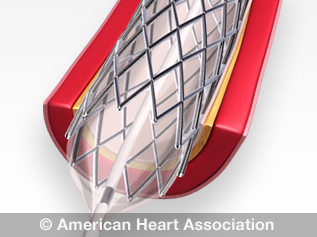What is a Stent?
Quick Facts
- A stent is a flexible tube placed in an artery to increase blood flow to the heart.
- Stents can help reduce the chance of a heart attack.
When plaque builds up in a coronary artery, it can narrow the artery. This may reduce blood flow to the heart and cause symptoms such as chest pain. If a clot forms in this narrow passage and completely blocks blood flow, it will cause a heart attack. A stent is a tiny wire mesh tube that keeps an artery propped open to increase blood flow to the heart.
Why do you need a stent in your heart?
If an artery is about 70% blocked, you may need a stent to keep it open, improve blood flow and relieve chest pain. Most stents are permanent and help reduce the chance of a heart attack.
Types of stents
Types of stents used to open coronary arteries:
- Bare metal stents are simple, metal mesh tubes.
- Biodegradable stents are temporary and dissolve after a few months.
- Drug-eluting stents are coated with medication that is released into the artery over time. This helps prevent the artery from narrowing again.
What to expect when getting a stent – during and after the procedure
Placing a stent is done through a minimally invasive procedure called percutaneous coronary intervention (PCI) or angioplasty (PDF). Your doctor will insert a thin, flexible tube called a catheter into your heart’s blood vessels. This tube has a balloon at the end, which will be inflated to open the narrowed artery and place the stent.After the procedure, you will likely be prescribe blood thinners to prevent blood clots from blocking the artery again. These medications may include aspirin, clopidogrel, dipyridamole and ticlopidine. You might need to take them for a year or longer.
Watch for complications after getting a stent. The risk of a blood clot is low unless you stop taking your blood thinners. Chest pain might be a symptom of restenosis. This is when the artery narrows again due to tissue growth. This can lead to a heart attack. If restenosis happens, you might need another procedure, such as placing a drug-eluting stent.
Talk with your health care professional about recovery time. Most people need a few days to a week before returning to work and physical activity. Also, check with your doctor about follow-up care. You may need to see a specialist such as a cardiologist or pulmonologist.
View: What is a Stent? (PDF)








